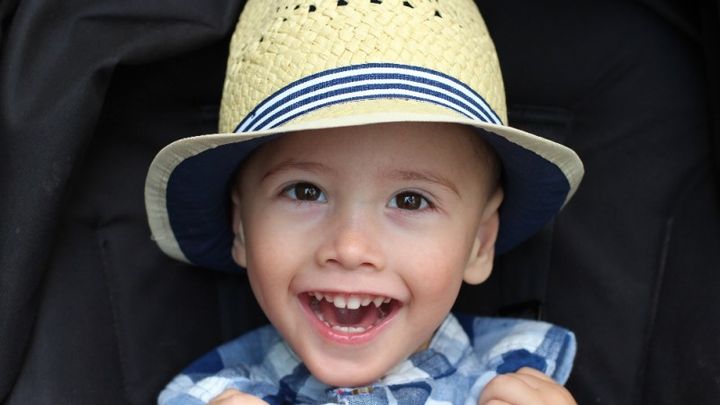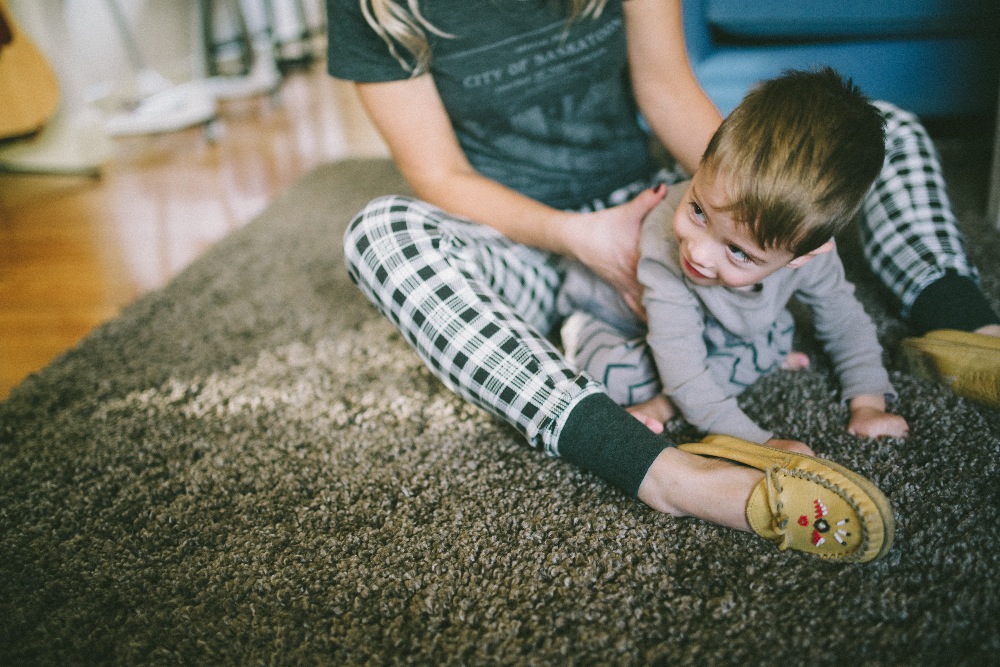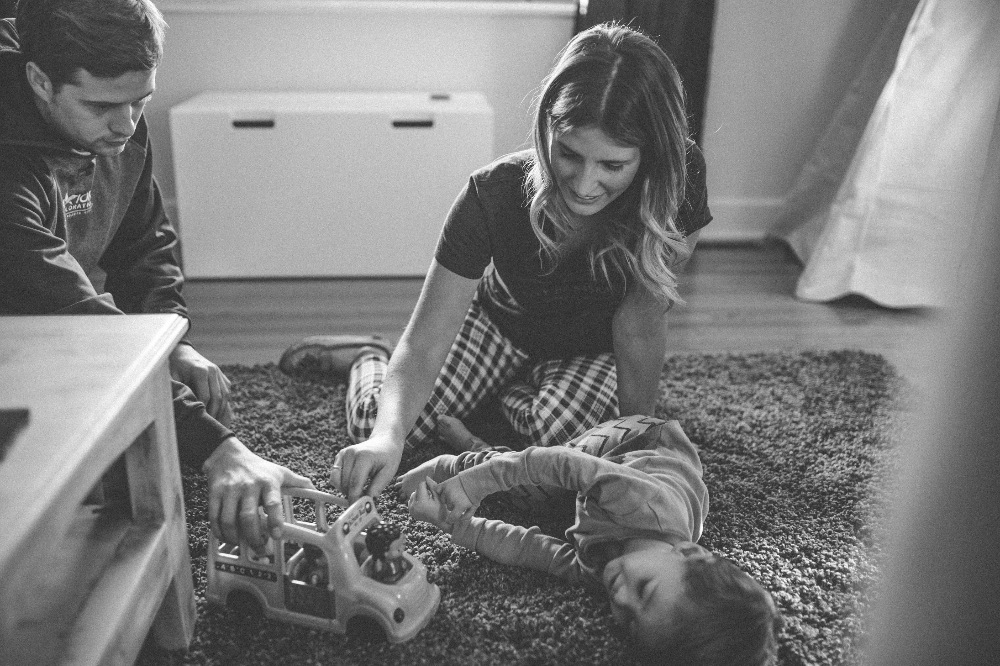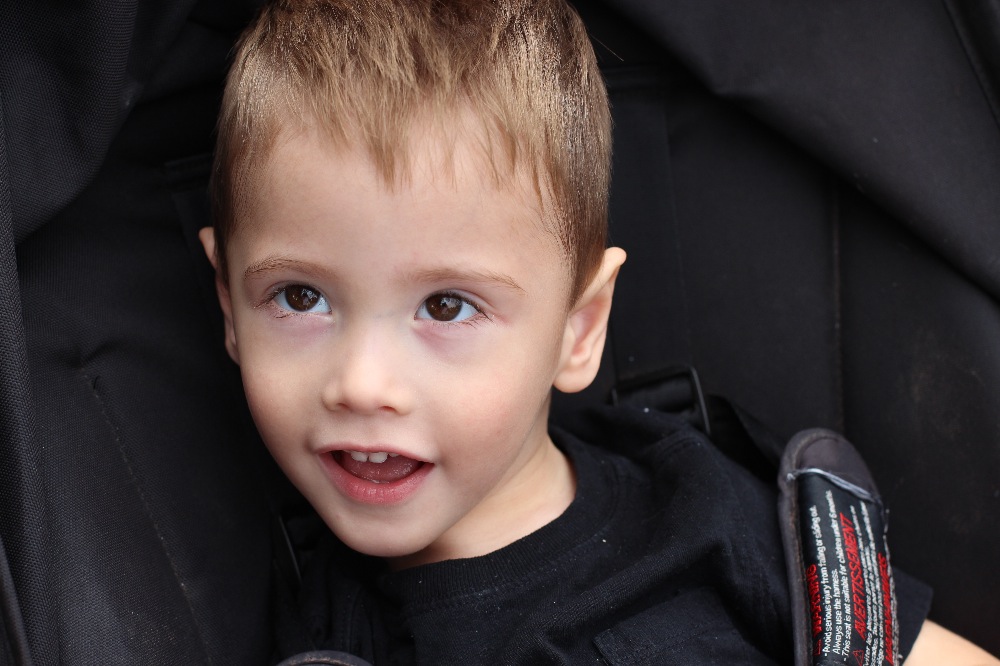
A Better Life for John
Donation protected
Our beautiful son John was born in October of 2012 with bilateral schizencephaly, a rare birth defect affecting the formation of the brain. Neurologists have told us that they believe John had a stroke in utero around 20 weeks.
Although John is very social and aware, the brain injury caused by the stroke has left John with a multitude of developmental delays, both physical and cognitive. At 17 months old, John was diagnosed with spastic quadriplegia cerebral palsy, caused by the schizencephaly. John’s arms and legs are very stiff and rigid from the spasticity which makes any movement extremely challenging for him. At 3 years old, John is unable to sit, crawl, walk, talk or feed himself.
For the past 3 years, we have tried numerous types of therapies and treatments to help improve John’s life and support his development including: physiotherapy, occupational therapy, speech therapy and an alternative therapy called the Anat Baniel Method. John is determined to move, but his spastic muscles are constantly fighting against him.
It wasn’t until a year ago that we learned of SPML (Selective Percutaneous Muscle Lengthening) and Alcohol Nerve Blocks. These are medical procedures that will provide relief to John’s spastic muscles not only relieving muscle pain, but it will give John the best chances at any type of movement, as well as help prevent future hip displacements and surgeries. The procedures are not available in Canada, and there are only two doctors in the world (Dr. Nuzzo in New Jersey and Dr. Yngve in Texas) who perform these orthopaedic procedures. It is our hope that we are able to take John to the New Jersey Children’s Hospital to have the procedures done.
Despite John’s challenges, he is an extremely happy, intelligent, creative and determined young boy. We are told that this procedure will allow John to reach new possibilities and will improve his quality of life.
We are grateful and thankful for any support and any contribution. Without your generosity these procedures would not be possible.
Sincerely,
Kurt, Karly and John



In our research we have discovered six important facts about SPML that we would like to share with you:
1. SPML can be done in legs, pecs, arms, hands, spine, toes, fingers, etc.
2. It is quite non-invasive as the surgeons do not use a knife. Traditional tendon lengthening causes scar tissue which is tight tissue in itself compounding the problem. There is little to no scar tissue with SPML since they do not use a knife.
3. SPML can be done on people of all abilities, someone like John or someone who is already walking.
4. SPML can be done as preventative procedure on kids as young as one or the elderly.
5. Being so tight and spastic is very damaging to the body causing deformities, twisting, hip and spine problems, contractures and loss of abilities. SPML is done in order to relieve this spasticity.
6. Doctors in Canada often suggest Botox as the only option to treat spasticity. Botox is temporary. SPML has a very low chance of needing repeating.


We know that this procedure can be very confusing, so we have provided more information from regarding SPML and Alcohol Nerve Blocks below. If you have any questions, feel free to send us a message on here, and we will reply.
What is SPML?
SPML (Selective Percutaneous Myofascial Lengthening) refers to an outpatient surgery under a general anesthetic for the treatment of the spasticity and tight tendons that are found in children with cerebral palsy. The word “Percutaneous” in the name SPML means using very small skin incisions 2-3 mm in length, so small that stitches are not needed. The SPML method was developed by Roy Nuzzo M.D. of Summit, NJ.
What is exactly done with the SPML procedure?
The SPML procedure involves releasing tight bands of tendon. This is done where muscle and tendon overlap. These areas of overlap are areas where a tendon starts to blend into a muscle. The tendon spreads out and is thinner at this location and is called Myofascia. When the myofascia is cut, the muscle under it can easily stretch and lengthen.
What part of the body can be treated with SPML?
Some children have tightness and spasticity in many locations in the legs. With the SPML procedure, many areas can be addressed during the same procedure.
Common areas for the SPML procedure are:
▪ at the low calf for ankle / calf / heel cord tightness and spasticity
▪ behind the knee for hamstring tightness and spasticity
▪ in the groin area for scissoring gait and groin spasticity
What age can be treated with the SPML procedure?
SPML works well for children of all ages and for adults. Because the SPML procedure uses micro incisions, very little scar forms. This is a good feature since scar is associated with recurrent contracture. This allows the SPML procedure to work well for all ages, including groups that have a reputation for recurrent contracture following conventional tendon lengthening surgery such as very young children, adolescents and adults.
What are the long term results of the SPML procedure?
The best data comes from Dr. Nuzzo’s web site where he reports a 5 year review of 278 cases. “Post op admissions were 0.01% (4 cases, single night). Repeat procedures at any location were 10%. Recurrence of operative site contracture occurred in 7%. There were no cases of infection, over lengthening, significant hematoma.”
Can the SPML procedure decrease spasticity?
Yes. Walking on a contracted joint puts a strong pull on the muscle- tendon unit with each step. This stimulates spasticity. Lengthening the muscle- tendon unit decreases the spasticity in that area. The beauty of the SPML procedure is that since it is practical with the minimal incisions to lengthen muscle- tendon units in many locations in the lower extremities, spasticity can be decreased in many locations.
What is an alcohol nerve block?
The alcohol nerve block is a common procedure that is done at the same time as the SPML procedure in children who have overactivity of the obturator nerves, which are nerves in the groin that contribute to stiffness of the hips or scissoring gait, in which the legs cross in front of each other in walking. The alcohol block is also used to decrease spasticity in the legs when it is associated with groin tightness. The alcohol block takes the nerve from overactive spasticity to a more normal state. It does this by dissolving the fatty coating, called the myelin sheath which is wrapped around the nerve. The nerve itself remains intact. The myelin sheath can grow back in about 3 years.

Although John is very social and aware, the brain injury caused by the stroke has left John with a multitude of developmental delays, both physical and cognitive. At 17 months old, John was diagnosed with spastic quadriplegia cerebral palsy, caused by the schizencephaly. John’s arms and legs are very stiff and rigid from the spasticity which makes any movement extremely challenging for him. At 3 years old, John is unable to sit, crawl, walk, talk or feed himself.
For the past 3 years, we have tried numerous types of therapies and treatments to help improve John’s life and support his development including: physiotherapy, occupational therapy, speech therapy and an alternative therapy called the Anat Baniel Method. John is determined to move, but his spastic muscles are constantly fighting against him.
It wasn’t until a year ago that we learned of SPML (Selective Percutaneous Muscle Lengthening) and Alcohol Nerve Blocks. These are medical procedures that will provide relief to John’s spastic muscles not only relieving muscle pain, but it will give John the best chances at any type of movement, as well as help prevent future hip displacements and surgeries. The procedures are not available in Canada, and there are only two doctors in the world (Dr. Nuzzo in New Jersey and Dr. Yngve in Texas) who perform these orthopaedic procedures. It is our hope that we are able to take John to the New Jersey Children’s Hospital to have the procedures done.
Despite John’s challenges, he is an extremely happy, intelligent, creative and determined young boy. We are told that this procedure will allow John to reach new possibilities and will improve his quality of life.
We are grateful and thankful for any support and any contribution. Without your generosity these procedures would not be possible.
Sincerely,
Kurt, Karly and John



In our research we have discovered six important facts about SPML that we would like to share with you:
1. SPML can be done in legs, pecs, arms, hands, spine, toes, fingers, etc.
2. It is quite non-invasive as the surgeons do not use a knife. Traditional tendon lengthening causes scar tissue which is tight tissue in itself compounding the problem. There is little to no scar tissue with SPML since they do not use a knife.
3. SPML can be done on people of all abilities, someone like John or someone who is already walking.
4. SPML can be done as preventative procedure on kids as young as one or the elderly.
5. Being so tight and spastic is very damaging to the body causing deformities, twisting, hip and spine problems, contractures and loss of abilities. SPML is done in order to relieve this spasticity.
6. Doctors in Canada often suggest Botox as the only option to treat spasticity. Botox is temporary. SPML has a very low chance of needing repeating.


We know that this procedure can be very confusing, so we have provided more information from regarding SPML and Alcohol Nerve Blocks below. If you have any questions, feel free to send us a message on here, and we will reply.
What is SPML?
SPML (Selective Percutaneous Myofascial Lengthening) refers to an outpatient surgery under a general anesthetic for the treatment of the spasticity and tight tendons that are found in children with cerebral palsy. The word “Percutaneous” in the name SPML means using very small skin incisions 2-3 mm in length, so small that stitches are not needed. The SPML method was developed by Roy Nuzzo M.D. of Summit, NJ.
What is exactly done with the SPML procedure?
The SPML procedure involves releasing tight bands of tendon. This is done where muscle and tendon overlap. These areas of overlap are areas where a tendon starts to blend into a muscle. The tendon spreads out and is thinner at this location and is called Myofascia. When the myofascia is cut, the muscle under it can easily stretch and lengthen.
What part of the body can be treated with SPML?
Some children have tightness and spasticity in many locations in the legs. With the SPML procedure, many areas can be addressed during the same procedure.
Common areas for the SPML procedure are:
▪ at the low calf for ankle / calf / heel cord tightness and spasticity
▪ behind the knee for hamstring tightness and spasticity
▪ in the groin area for scissoring gait and groin spasticity
What age can be treated with the SPML procedure?
SPML works well for children of all ages and for adults. Because the SPML procedure uses micro incisions, very little scar forms. This is a good feature since scar is associated with recurrent contracture. This allows the SPML procedure to work well for all ages, including groups that have a reputation for recurrent contracture following conventional tendon lengthening surgery such as very young children, adolescents and adults.
What are the long term results of the SPML procedure?
The best data comes from Dr. Nuzzo’s web site where he reports a 5 year review of 278 cases. “Post op admissions were 0.01% (4 cases, single night). Repeat procedures at any location were 10%. Recurrence of operative site contracture occurred in 7%. There were no cases of infection, over lengthening, significant hematoma.”
Can the SPML procedure decrease spasticity?
Yes. Walking on a contracted joint puts a strong pull on the muscle- tendon unit with each step. This stimulates spasticity. Lengthening the muscle- tendon unit decreases the spasticity in that area. The beauty of the SPML procedure is that since it is practical with the minimal incisions to lengthen muscle- tendon units in many locations in the lower extremities, spasticity can be decreased in many locations.
What is an alcohol nerve block?
The alcohol nerve block is a common procedure that is done at the same time as the SPML procedure in children who have overactivity of the obturator nerves, which are nerves in the groin that contribute to stiffness of the hips or scissoring gait, in which the legs cross in front of each other in walking. The alcohol block is also used to decrease spasticity in the legs when it is associated with groin tightness. The alcohol block takes the nerve from overactive spasticity to a more normal state. It does this by dissolving the fatty coating, called the myelin sheath which is wrapped around the nerve. The nerve itself remains intact. The myelin sheath can grow back in about 3 years.

Organizer
Karly Gress
Organizer
Calgary, AB


